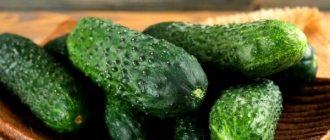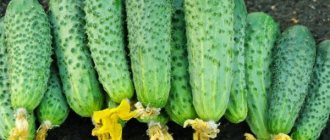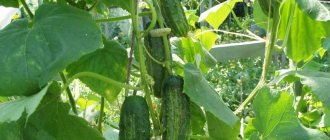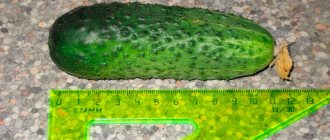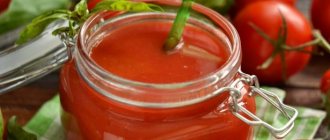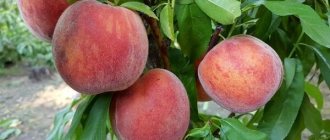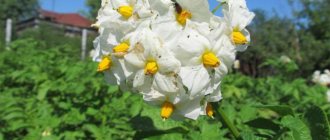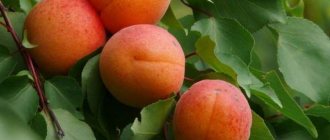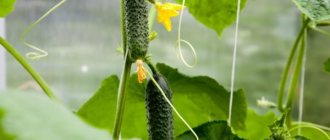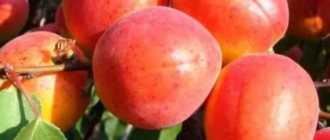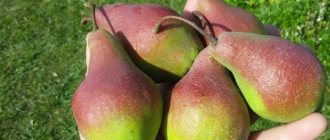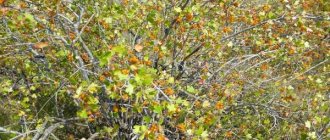It’s worth starting the description of the cucumber variety Bjorn f1 with the fact that this is one of the new hybrids focused on resistance to difficult climatic conditions. Its ripening period is ultra-early: the cucumber ripens completely in 35-40 days. The variety feels best in greenhouse conditions. Cultivation in open ground is permissible only in the southern regions.
Description of the cucumber variety Bjorn
Hybrid Bjorn F1 is parthenocarpic, or self-pollinating. It does not need insects for pollination. Thanks to this property, the variety bears fruit well in greenhouses where there are few insects.
Cucumber Bjorn F1 is a slender plant with large green leaves and a powerful root system. It forms a compact open bush as its leaf cover is not too dense. The plant has short side shoots, which makes it easier to care for.
The hybrid produces cucumbers of the usual gherkin size - 10-12 cm. Cucumbers grow uniform, tasty, without bitterness. They are well suited for making salads, pickling and marinating.
Landing regions
The hybrid is stable and stress-resistant. It forms ovaries well and does not shed them due to temperature changes and insufficient lighting. The variety is suitable for cultivation both in greenhouses and in open ground. It produces good yields in different climatic zones: in the southern regions and the Volga region.
Description of the plant
Externally, it is a plant with underdeveloped side shoots, but a powerful main stem that has no natural growth restrictions. It grows weakly and is not oversaturated with green matter. Thanks to this, the bush is easy to care for and harvest, and does not require pinching. It blooms according to the female type - without empty flowers, the inflorescences are collected in a bouquet, in which about 5 fruits can be formed. The root system is well developed.
Description of fruits
The vegetables are dark green with small pimples and have a uniform density. The average size of a cucumber is 9-12 cm (gherkin), the taste is pronounced, the vegetable is not bitter.
Photo
In the photo below you can see the Bjorn cucumber:
You can also watch a video where an experienced gardener will tell you how the Bjorn variety grew in a greenhouse.
Hybrid Bjorn F1 gives an excellent harvest. If you haven't tried growing it in your garden yet, be sure to give it a try. Believe me, the results will not disappoint.
Application area
Fruits are universal in use
After the cucumbers reach the desired size, they are picked immediately so that they do not become overripe (otherwise their peel becomes rough and the texture becomes watery). You need to pick cucumbers every 2 days.
Variety Bjorn F1 is suitable for:
- pickling (cucumber size – 8-12 cm);
- canned food (up to 10 cm, small cucumbers are crispier);
- slicing for salads (from 10 cm).
Sustainability
Björn, like all hybrids, has good phytoimmunity, but with improper care and in bad weather conditions he can also get sick. The most common cultural pathologies:
Plants are often attacked by insect pests. More often this happens during the fruiting period. The most common parasites include spider mites. He especially loves greenhouse conditions. The pest is located at the bottom of the leaf blade and leaves a web there. Spider mites eat the green mass of plants. To remove it, cucumber leaves are sprayed (100 g of soap dissolved in 5 liters of water). The lower parts of the leaf plates are treated especially carefully.
Cucumbers can also be threatened by aphids. This is a small green insect that inhabits bushes in entire colonies and eats them, which leads to the withering of the tops. Aphids multiply quickly and can attack other crops that grow in neighboring beds. They fight it by using an ash solution (100 g of ash and 50 g of laundry soap per 5 liters of water). Whiteflies can also be classified as dangerous insects. She looks like a light-colored small midge. The whitefly drinks cucumber juice and leaves behind sooty fungus and wilted leaves. Get rid of the pest using garlic infusion (100 g of garlic is grated and poured into 5 liters of water, allowed to brew for 24 hours).
Characteristics of Bjorn cucumbers
The variety is only a few years old, it comes from Holland. Breeding work was aimed at consolidating the characteristics of self-pollination and high yield.
Resistance to diseases and pests
Breeders have endowed the cucumber with high resistance to mosaic virus, olive spot, powdery mildew, and cladosporiosis. Pests affect it moderately, the most common of which are aphids, spider mites, and sometimes whiteflies. When there are few insects, you can prepare a soap solution and wash the leaves with a sponge. A decoction of garlic against spider mites and a decoction of tobacco against aphids are also effective. For severe lesions, insecticides are used.
Expert opinion: Cucumber Bjorn F1 has earned a lot of rave reviews. Gardeners note its unpretentiousness, ease of cultivation, ease of harvesting and transporting crops, as well as the excellent taste that decorates any dish.
Ripening time
Hybrid Bjorn F1 is one of the earliest varieties of cucumbers. The period from planting to harvest is from 35 to 39 days. This variety is a hybrid of the “Sprinter” type. He gives away the harvest within two to two and a half months.
In film greenhouses, the variety and in protected soil conditions, cucumbers can be grown in two rotations.
Productivity
The variety is characterized by high productivity and abundant fruiting. The fruits on the bush ripen together. The bulk of cucumbers grow on the main stem, which makes harvesting easier. Plants have a bouquet type of flowering. In each axil, 3-4 ovaries are formed, and all greens ripen. The variety produces large tuberculate fruits of uniform shape throughout the entire fruiting period. When overgrown, cucumbers do not barrel.
Features of cultivation
Currently, gardeners use two methods of planting this plant: seed and seedlings.
Growing seedlings is more profitable, as it allows you to get a rich harvest. Before sowing, the seeds are stratified:
- The selected seed material is immersed in a weak solution of potassium permanganate for half an hour.
- then washed, dried and wrapped in a damp cloth. The seeds are stored in a moist environment until they are hatched.
- Germinated seeds are planted in seedling boxes with loose and slightly acidic soil.
- The best time for landing is mid-April.
Reviews from gardeners
Gardeners really like this variety because of its characteristics. Manufacturers position Bjorn F1 as a salad variety, but experienced summer residents claim that these cucumbers are ideal for preserving for the winter.
They have a marketable appearance, high resistance to different weather conditions, excellent transportability and a long shelf life, which is why they are chosen by gardeners. The Björn cucumber is delicious both fresh and processed, and the yield if grown correctly will please everyone.
Growing cucumbers Björn
Björn cucumbers are cultivated both using seedlings and without seedlings. Let's take a closer look at each of them.
Landing dates
Seeds for seedlings of the variety begin to be planted in a greenhouse or greenhouse in the first half of April. Cucumbers begin to be introduced into open ground (in the southern region) in the last days of this month. The recommended temperature for germination is 23°-25°. In open ground, Bjorn f1 plantings are covered with film at night so that they are not destroyed by nighttime temperature changes.
They try to plant the variety after the heaviest spring frosts have passed.
Site preparation
They begin to prepare the soil for planting the Björn hybrid in September. The area is thoroughly cleaned of debris and weeds (down to small roots), after which it is dug deep to 40-50 cm. Then the soil for the cucumber is disinfected with a solution of potassium permanganate and fertilized with organic matter - mullein, humus, or urea solution. With the onset of spring, 3-4 days before planting the seedlings, the soil is once again loosened, weeded, holes are cut into which wood ash and rotted sawdust are placed - cucumber loves organic matter.
Planting seedlings
When using this planting method, the yield of ripe fruits increases, they ripen earlier, and the fruiting period is extended. Seeds are sown depending on where the seedlings will grow in the future: for greenhouses - April, open ground - May. To do this, you need to prepare peat pots; plant two seeds in each container. Water with warm water and repeat this procedure daily. After 4-5 days sunrises appear. After the formation of 3-4 full leaves, the plant is replanted, leaving at least 160 cm of distance between the rows, and about 30 cm between the plants themselves.
Did you know? Cucumbers contain the glycoside cucurbitacin, which inhibits the growth and development of cancer cells.
Planting scheme
Despite the small size and modest foliage of the Bjorn f1 bushes, they require a spacious area. The maximum number of plants of the variety per 1 m² is no more than 4. The ideal distance between neighboring bushes is 40 cm. But the row spacing for planting Bjorn is left very wide - 1.5 m. This is done to prevent the rapid spread of viruses and parasitic insects between adjacent rows of the variety. Finally, the depth of cucumber holes recommended in the description is 4-5 cm in loam and 6 cm in black earth soil.
Growing cucumbers using the seedless method
Björn cucumbers are also planted directly in open ground, without first growing seedlings. The end of May is ideal for this, when the soil has warmed up to +13°C. The soil is pre-watered, the seeds are lowered to a depth of 2-3 cm so that there are up to 7 bushes per 1 m², after which they are covered with a mixture of earth and humus.
Landing
You can plant Bjorn F1 either with seeds directly into the ground or with prepared seedlings. Planting with seeds is most often carried out for growing in a greenhouse, and seedlings are used when the plant is placed in open ground. Gardeners believe that more harvest can be harvested from a bush planted using the seedling method (up to 20 kg per plant).
Seed planting technology
To plant Bjorn f1 cucumbers, you need to choose seeds from trusted manufacturers and suppliers, then the result will meet your expectations. The price of high-quality Dutch seeds can range from 270 to 1,400 rubles. per package (depending on the number of pieces). They have already been processed and are ready for planting in open ground.
If the seeds are prepared at home, before sowing they need to be soaked in warm water (35-40 ° C) for 2-3 hours, and then put in a rough wet cloth and left for 2-3 days so that they swell, then they will rise faster. If the material was purchased in a store, no manipulations are necessary before planting.
Seeds should be planted in the following way: the distance between rows of bushes should be approximately 150 cm. In a row, the distance from one bush to another should not be less than 35 cm (and more than 60 cm). The depth of the holes for sowing seeds is 7-9 cm.
Using seedlings
Planting of seedlings is carried out at the same distances, this promotes optimal growth of the crop. Seedlings need special care: the seeds are planted in a peat pot to a depth of 3-4 cm, watered and covered with film or glass until germination (then the film is removed so that the seedlings can “breathe”).
Temperature range – from 14 to 20 °C. On the 20th–24th day, the seedlings are planted directly on the beds in the greenhouse or garden. This should be done together with a peat pot, slightly damaging its walls for better access of moisture to the roots.
Caring for Bjorn cucumbers
The plant must be fertilized.
Caring for Bjorn f1 cucumbers does not cause much trouble, but the description of the variety indicates that certain rules must be observed:
- feed the bush (at least 4 times per season). The first feeding is done approximately on the 15th day after planting in the ground, the second - at the beginning of flowering, then - during the period of fruit ripening. Fertilizing should be alternated: once mineral (preparations “Agricola”, “Master”, superphosphate), the next - organic (manure, grass infusion, chicken droppings diluted with water in a ratio of 1:15). Next time, fertilizing is done to extend the fruiting time;
- it is necessary to loosen the soil. Thanks to this, the soil is saturated with oxygen, weeds that take moisture from the bush are mechanically removed. You need to loosen the soil 2-3 times per season. Make sure that nothing prevents the bush from growing.
Watering
Cucumbers should be watered exclusively with water at room temperature and in the evening or early in the morning (if you water during the day, the heat will cause a crust to form on the ground).
Cold water affects the root system, which begins to rot because of this. You need to pour water under the bush, not on the leaves.
Top dressing
Cucumber needs frequent nutritional feeding - usually it alternates between mineral liquid mixtures and organic matter. Bjorn f1 is fertilized on average 6 times per season. The recommended feeding scheme is as follows:
- The first two feedings are mineral - as the 2nd and 4th leaves appear. Potassium nitrate, or potassium sulfate, is used for the variety.
- The next important stage is the beginning of flowering. During this period, the cucumber needs to be fed with organic matter - a solution of chicken droppings, or humus.
- Finally, the last stage is the beginning of fruiting. At this time, the variety is fertilized with superphosphate and urea solution - alternately.
Fertilizers are applied in a thin layer under the root of the hybrid Bjorn f1, every 10 days.
Hilling
The bushes of the variety are sprinkled with earth after every second watering. In cool, wet weather - after each watering or precipitation. Each Bjorn f1 plant is hilled to a height of 20 cm. The soil is poured onto the cucumber along with mulch scattered between the rows - hay, sawdust, or peat.
In addition to hilling, the variety also needs regular loosening - after each watering or rain. You need to loosen the cucumber carefully, shallowly, so as not to touch the roots located close to the surface. Weeding is also of particular importance - Bjorn is weeded once every 4-5 days, clearing the area even of small roots and debris caused by birds.
Garter and bush formation
Bjorn f1, judging by the description, is able to independently control lateral branching, so its bushes do not need complex formation. The variety does not require the formation of a plant into one central stem - this usually happens automatically. As the Bjorn sprouts reach 25-30 cm, they are tied to vertical trellises so that the leaves do not touch the ground. Finally, since this is an unlimited growth variety, the top of each Bjorn bush is pinched at a height of 1.5 m.
Bush formation
There is no need to shape the cucumber stem. The plant can cope with this process on its own. In greenhouses, bushes are grown using trellises. You need to start forming a bush from the moment it has about 10 leaves. Later, if excess leaves and stems are not removed, cucumbers may be susceptible to diseases and pests.
When the plant reaches approximately 2 m vertically on the trellis, it should be pinched back above the 3rd or 4th leaf of the main stem. When gartering cucumbers on trellises, you need to be careful not to crush the stem, otherwise the plant will not receive enough nutrients. With proper formation of the bush, Bjorn F1 produces more high-quality fruits.
Collection and storage
Cucumbers are harvested as soon as they reach the desired size:
- 8-12 cm for pickling;
- 8-10 cm for canning;
- From 10 cm for salad.
During the period of abundant fruiting, cucumbers are harvested at least once every two days, otherwise the fruits will overgrow.
The fruits are collected early in the morning or late in the evening - this way they are better preserved. Cucumbers are picked carefully so as not to damage the vine. It is best to cut them with a knife. Unsuccessful fruits are immediately removed: “hooks”, “bumps”, cucumbers with scratches and spots.
The collected fruits are immediately placed in a cool place. Hybrids are distinguished by keeping quality and transportability. They can be stored in a plastic bag in the cellar or in the refrigerator.
Pests and diseases
Cucumbers are often attacked by pests. They especially often settle in greenhouses.
- Whitefly is an insect 2mm long. She sucks the juice from the cucumbers. Insects usually congregate on the undersides of leaves. If they are not destroyed, the plant will wither and die.
- Aphid. These pests are highly voracious and prolific. Aphids suck the juice from cucumbers. Aphid colonies can cause severe damage to plants.
- Slugs. These pests come out at night and crawl on plants. They leave behind a slimy residue that harms the plants. Slugs are voracious creatures. They can destroy the entire cucumber crop.
- Putin ticks. They are often bred in greenhouses where it is warm and humid. Mites collect on the inner surface of leaves. They can be seen by the cobwebs on plants. Ticks suck the juice from the leaves. Marble spots appear on the leaves and they die.
